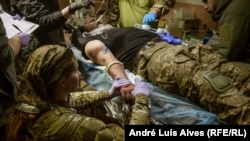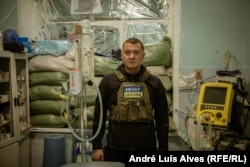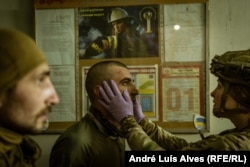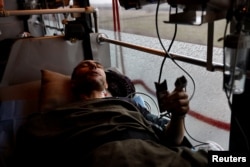NEAR BAKHMUT, Ukraine -- It was still completely dark when Mykyta Zavilinskiy woke up at 4 a.m. and rushed out of his unit's base to evacuate a wounded soldier from the battlefield in the Donbas region.
The semiconscious man had multiple shrapnel wounds and was losing blood. With injuries from his feet to his torso, putting tourniquets on his legs was impossible, so the medics tamponed his wounds one by one with their fingers.
The driver of their Mitsubishi pickup truck was speeding 150 kilometers per hour under the Russian fire control to get to a safer spot. As the sun started to rise, the monitors inside the car showed that the patient's oxygen saturation was up, and his heart rate was down.
"My partner and I traded looks and understood that he was stabilized," Zavilinskiy, 33, said, recalling his first medical evacuation from the front line in late April 2022. He described it as "one of the most emotional moments" of his life.
Since then, he has taken part in over 200 evacuations along with other members of the Hospitallers Medical Battalion, a Ukrainian organization of volunteer medical professionals. With the Russian Army pushing forward in several segments of the 1,200-kilometer front line and another winter of intense fighting approaching, he is sure many more lie ahead.
Heroes Without Supplies
For over 20 months of all-out war against the Russian invasion, thousands of Ukrainian doctors, nurses, and paramedics have been saving lives amid the carnage of Europe's biggest post-1945 war.
To the popular imagination, they have become symbols of perseverance and hope. But in reality, combat medics in Ukraine face daunting problems that eventually led to the November 19 dismissal of Commander of the Medical Forces Tetyana Ostashchenko by President Volodymyr Zelenskiy.
The move was preceded by growing frustration over poor-quality supplies, alleged corruption, and a lack of sufficient medical training. The loudest scandal revolved around cheap, poor-quality tourniquets, many of them made in China, that literally cost soldiers' lives.
On July 31, opposition lawmaker Solomia Bobrovska said the military's Medical Forces command did not purchase any first-aid kits in 2023, and those provided through international aid were not properly checked.
Ostashchenko dismissed this statement as untrue and said the problems Ukraine faced had no precedents in modern times. At the same time, the General Staff vowed to undertake "several steps and organizational changes designed to solve problems in the field of tactical medicine."
The effect of those was apparently insufficient, and Ostashchenko had to give way to Anatoliy Kazmirchuk, head of a military hospital in Kyiv, as the new commander.
In a video address justifying the change, Zelenskiy explained that society, and especially the combat-medics community, demanded a "fundamentally new level of medical supply for our soldiers."
Zelenskiy indicated that many changes were needed.
"From high-quality tourniquets to full digitalization and transparency in supplies, from high-quality training to honest communication with combat medics in those units that are functioning properly and efficiently," he said.
At The Stabilization Point
Providing proper first aid and quick evacuation from the battlefield -- ideally taking place within the so-called golden hour when the likelihood of medical and surgical intervention preventing death is highest -- is crucial to saving soldiers' lives.
Once the wounded are pulled out of battle, often after too many hours waiting for help, they're brought to a stabilization point where doctors and paramedics try to keep them alive long enough to make it to the hospital.
"Most patients arrive here in serious condition, often on the verge of death," Oleksiy Marchenko, 42, told RFE/RL during a mid-November visit to a stabilization point near Bakhmut, a now ruined city in the Donetsk region that fell to fighters of Russia's notorious Wagner mercenary group and other forces in May after many months of grueling warfare.
Since Ukraine liberated the villages of Klishchiyivka and Andriyivka on Bakhmut's southern outskirts in September, Russian forces have been trying to retake the initiative here, meaning regular infantry assaults and artillery shelling.
On average, 50 wounded soldiers are brought to the stabilization point daily, but as many as 200 can arrive at times, Marchenko says, adding that 80 percent of wounded suffer from blast injuries caused by mines or artillery fire. Before he spoke with RFE/RL, he had performed three operations, including a leg amputation.
"What strikes me most were the hundreds of soldiers who were here three times, but they still came back to fight alongside their comrades," he said.
Reasons For Optimism
Several doctors and combat medics told RFE/RL there are reasons for optimism despite the dire reality of grinding warfare.
Marchenko's colleague, Volodymyr Veselovskiy, 36, told RFE/RL the team of 20 doctors and paramedics working alongside them had substantially refined the way they work since the beginning of Russia's full-scale invasion. He said the results of transitioning from Soviet-style care to NATO standards were already visible.
Dozens of freshly washed tourniquets, devices designed for single use, had been hung on the wall at the stabilization point to dry. But overall, the facility had modern equipment and full stocks of disposable materials. Most of it comes from volunteers and donors, Veselovskiy said, adding that state support is also becoming more robust.
That was not always the case. Katarzyna Daniszewska, a Polish medic and head of the Awangarda volunteer group that has been helping medics and evacuation teams since the beginning of the full-scale invasion, said battlefield medicine in Ukraine was "evolving very rapidly."
Most of the positive changes, however, have been driven by the bottom-up impulses of soldiers and units trying to increase their chances of survival, she said.
Daniszewska spent multiple months working at various stabilization points, including one close to Bakhmut during the period of the most intense fighting there. "In the beginning, there was a shortage of equipment for bone and blood injections, and now advanced transfusion fluids are the norm," she said.
In September, after months of negotiations between Ukraine's Defense Ministry, Health Ministry, and the Medical Forces Command, the government granted combat medics, even those without medical degrees, permission to perform blood transfusions prior to the hospitalization of wounded soldiers -- a decision widely perceived as a symbolic recognition of their increasing professionalization.
"Every month, specific units and brigades are becoming more self-sufficient," Daniszewska said, adding that she remains impressed by the army's high morale despite months of exhausting warfare.
Incessant Stream Of Wounded
With no end to the fighting in sight, the stream of wounded soldiers evacuated from the battlefields, rescued at stabilization points, and treated in hospitals seems unending.
Neither Ukraine nor Russia discloses information about their casualties, but according to unofficial U.S. estimates, reported by The New York Times in mid-August, Ukraine's losses amount to about 70,000 soldiers killed and 100,000 to 120,000 wounded, while Russia's are about 120,000 and 170,000 to 180,000, respectively.
Zelenskiy recently said Ukrainian losses were "five times less" than Russia's, but he has also indicated that hundreds of Ukrainian soldiers are being killed or wounded every day during the most intense periods of fighting.
On a recent evening, a team of medics from the MOAS aid organization, which transports the most severe cases from stabilization points to hospitals, was evacuating a severely injured man. That morning, he stepped on a land mine; his feet were torn to pieces and half of his body burned.
Surrounded by beeping monitors and life-support equipment, Alla Molochko, the doctor treating him, said the soldier would survive but a long rehabilitation awaited him. The ambulance was racing at 130 kilometers per hour to get him to a hospital in Dnipro and return to the organization's base in the Donbas.
More severely wounded men were waiting for them.















